Physical Address
304 North Cardinal St.
Dorchester Center, MA 02124
The 20th century witnessed a remarkable decline in the mortality from cervical cancer in developed countries, an achievement attributable to the implementation of the Papanicolaou (Pap) test. In the 1930s, before Pap test screening was introduced, cervical cancer was the most common cause of cancer deaths in women in the United States. Today it is not even in the top 10, but it has not been eradicated; there are still approximately 13,000 new cases of cervical cancer in the United States each year, with 4000 deaths. Worldwide, cervical cancer incidence (over 500,000 cases annually) and mortality (over 300,000 deaths per year) rank fourth, after breast, lung, and colorectal cancers. Indeed, in some countries (e.g., those in sub-Saharan Africa), cervical cancer remains the most common type of cancer in women. Unfortunately, screening programs are rudimentary or nonexistent in many parts of the world: fewer than 5% of women in developing countries have ever had a Pap test. In contrast, 89% of women in the United States report having had a Pap test in the preceding 5 years.
Around the world, Pap test screening is implemented in two different ways, commonly referred to as opportunistic versus organized . An organized screening program is planned at the national or regional level. It specifies a target population and screening intervals and has a mechanism for inviting women to attend screening services, informing them of their result, and referring them for treatment. Opportunistic screening , the system in place in the United States, for example, is done independently of an organized or population-based program, often for women who are visiting health services for other reasons. Screening is recommended during a consultation or requested by the woman. Opportunistic screening tends to reach younger, lower-risk women who are attending family planning and antenatal services. Organized screening is more cost-effective than opportunistic screening, making better use of available resources and ensuring that the greatest number of women benefit.
The Pap test is the most successful cancer reduction program ever devised. Credit for its conception and development goes to George N. Papanicolaou, an anatomist and Greek immigrant to the United States. In 1928 he reported that malignant cells from the cervix can be identified in vaginal smears. Later, in collaboration with the gynecologist Herbert Traut, who provided him with a large number of clinical samples, Papanicolaou published detailed descriptions of preinvasive cervical lesions. Pathologists and clinicians initially greeted this technique with skepticism, but by the late 1940s Papanicolaou’s observations had been confirmed by others. The Canadian gynecologist J. Ernest Ayre suggested taking samples directly from the cervix with a wooden spatula rather than from the vagina with a pipette as originally described by Papanicolaou. Eventually, cytologic smears were embraced as an ideal screening test for preinvasive lesions, which, if treated, would be prevented from developing into invasive cancer.
The first cervical cancer screening clinics in the United States were established in the 1940s. Although it was not evaluated in a controlled, prospective study, several pieces of evidence link the Pap test to the prevention of cervical cancer. First, the mortality rate from cervical cancer fell dramatically after screening was introduced, by 72% in British Columbia and 70% in Kentucky. Second, there was a direct correlation between the intensity of screening and the decrease in mortality. Among Scandinavian countries, the mortality rate fell by 80% in Iceland, where screening was greatest; in Norway, where screening was lowest, the mortality rate fell by only 10%. A similar correlation was observed in high and low screening regions of Scotland and Canada. In the United States, the decrease in deaths from cervical cancer was proportional to the screening rates in various states. Finally, women who do not develop invasive cancer are more likely to have had a Pap test than women with cancer. In a Canadian study the relative risk for women who had not had a Pap test for 5 years was 2.7, and screening history was a highly significant risk factor independent of other factors such as age, income, education, sexual history, and smoking. In Denmark a woman’s risk of developing cervical cancer decreased in proportion to the number of negative smears she had had: by 48% with just one negative smear, 69% with two to four negative smears, and 100% with five or more smears. More recently, prospective studies from Japan and Sweden have provided additional evidence that the Pap test significantly reduces the incidence of and mortality from cervical cancer.
Cervical cancer screening guidelines differ around the world. In the United States, recommendations are issued by the American College of Obstetricians and Gynecologists, the US Preventive Services Task Force, and a consortium of the American Cancer Society, the American Society for Colposcopy and Cervical Pathology (ASCCP), and the American Society for Clinical Pathology. Their guidelines differ in minor ways, but there is general agreement on the larger points, including longer screening intervals and a later age to start screening (age 21) than had been recommended in the past ( Table 1.1 ). For women 21 to 29 years of age, they recommend a Pap test every 3 years. For women between ages 30 to 65, there are several options: a Pap test alone every 3 years; a test for high-risk types of the human papillomavirus (HPV) every 5 years; or a “cotest” (a Pap plus an HPV test) every 5 years. The guidelines address women with an average risk for cervical cancer. Women at higher risk—those with a history of cervical cancer, in utero diethylstilbestrol (DES) exposure, and immunocompromise (due to organ transplantation, chemotherapy, long-term corticosteroid treatment, or infection with the human immunodeficiency virus [HIV])—may benefit from more frequent screening. Because women with human immunodeficiency virus/acquired immunodeficiency syndrome have higher rates of cervical cancer than the general population, it is recommended that HIV-seropositive women have a Pap test twice during the first year after diagnosis of HIV infection and, if the results are normal, annually thereafter. Adherence to screening guidelines is critical for cervical cancer prevention: in Sweden, for example, women who had not had a Pap test within the recommended screening interval had a higher risk of cervical cancer than those who had been screened (odds ratio 2.52).
| Circumstance | Recommendation |
|---|---|
| Age to begin screening | Age 21. Women younger than age 21 should not be screened, regardless of the age of sexual initiation |
| Women aged 21 to 29 | Every 3 years with cytology (liquid-based or smears) alone |
| Women aged 30 to 65 | Every 3 years with cytology alone, or every 5 years with HPV, or every 5 years with cytology and HPV (“cotest”) |
| Discontinuation of screening | Age 65 years if adequate prior screening and no history of CIN 2 or higher ∗ |
| Screening after total hysterectomy | Not recommended if no history of CIN 2 or higher |
∗ ACOG and ACS/ASCCP/ASCP define “adequate prior screening” as three consecutive negative cytology results or two consecutive negative cotest results within the previous 10 years, with the most recent test performed within the past 5 years. “No history of CIN 2 or higher” defined by ACS/ASCCP/ASCP as within the last 20 years.
Because of the strong association between HPV and cervical neoplasia (see “Squamous Intraepithelial Lesions” below), a test for high-risk HPV types can be used by itself as an initial screen (so-called “primary HPV screening”). If positive, partial genotyping (for HPVs 16 and 18) and Pap cytologic study are performed; a referral to colposcopy is recommended if genotyping shows HPV 16 or 18, if the Pap cytology result is abnormal, or if a subsequent HPV test shows persistence of virus. There is evidence that primary HPV screening is equivalent or superior to screening algorithms based on Pap cytologic study, and the US Food and Drug Administration (FDA) has approved the Roche cobas HPV Test and the BD Onclarity HPV Assay for primary HPV screening. The International Agency for Research on Cancer and the World Health Organization have endorsed primary HPV testing, and in 2017 the Netherlands was the first country to implement it nationwide.
In 2012, the ASCCP revised its guidelines for the management of women with abnormal cervical cytologic study, HPV, and histopathologic results. These guidelines, mentioned throughout this chapter in the relevant sections, apply only to women whose abnormalities are detected during screening. Management is individualized for women with postcoital or unexplained abnormal vaginal bleeding, pelvic pain, abnormal discharge, or a visible cervical lesion.
The development of prophylactic HPV vaccines has opened a new opportunity for cervical cancer prevention. The vaccines consist of empty protein shells called virus-like particles that are made up of the major HPV capsid protein L1; they contain no DNA and are not infectious. Two of the vaccines are Gardasil and Gardasil 9 (Merck & Co., Inc.). Gardasil is a quadrivalent vaccine against HPV types 6, 11, 16, and 18, and Gardasil 9 is a nine-valent vaccine against HPV types 6, 11, 16, 18, 31, 33, 45, 52, and 58. A third vaccine—Cervarix (GlaxoSmithKline)—withdrew from the US market in 2016 due to low market demand. They have all shown extraordinary efficacy in preventing type-specific histologic CIN 2,3 lesions, with no difference in serious adverse effects compared with placebo. The American Cancer Society recommends routine HPV vaccination for girls and boys ages 11 and 12 years. It also recommends the vaccine to males and females ages 13 to 26 to “catch up,” having missed the opportunity to be vaccinated at the recommended age. In 2016, it was estimated that 65% of girls and 56% of boys aged 13 to 17 years in the United States had initiated HPV vaccination. Of note, screening guidelines are no different for the vaccinated population as compared with those not vaccinated. Continued screening, even for the vaccinated population, remains important because (1) these vaccines do not protect against all cervical cancers; (2) the duration of protection is unknown; (3) they are not effective in treating prevalent HPV infections; and (4) the cost of the vaccines might limit their use in some populations.
To obtain an ideal Pap specimen, the American Cancer Society recommends the following patient instructions :
Try not to schedule an appointment for a time during your menstrual period. The best time is at least 5 days after your menstrual period stops.
Don’t use tampons, birth-control foams, jellies, or vaginal creams, lubricants, or medications for 2 to 3 days before the test.
Don’t douche for 2 to 3 days before the test.
Don’t have vaginal sex for 2 days before the test.
Once the patient is positioned, a bivalve speculum of appropriate size is gently inserted into the vagina.
The speculum can be lubricated with warm water or sparingly applied water-soluble lubricant.
Excess mucus or other discharge should be removed gently with a cotton swab.
The sample should be obtained before the application of acetic acid or Lugol’s iodine.
An optimal sample includes cells from the ectocervix and endocervix.
Water-soluble gel lubricant, if used, should be applied sparingly to the posterior blade of the speculum, avoiding the tip: excessive lubricant can result in an unsatisfactory specimen. When visible, different lubricants have different effects and different appearances on cytologic preparations. It can be helpful to check any guidelines issued by the manufacturers of liquid-based cytology instruments with regard to recommended lubricants. In particular, lubricants containing carbomers or Carbopol polymers have a deleterious effect on ThinPrep (Hologic, Malborough, MA) slides and should be avoided.
There are no clinically important differences between smears and liquid-based cytology methods, and therefore either is considered acceptable for cytologic screening.
Smears are often prepared using the combination of a spatula and brush. The spatula is used first. Although a wooden or plastic spatula is acceptable, the plastic spatula is recommended because wooden fibers trap diagnostic material. The spatula is rotated at least 360 degrees. The sample can be smeared on half of a slide and spray fixed (the other half should be covered to avoid coating it with fixative before the endocervical sample is applied). Alternatively, one may set aside the spatula sample momentarily while the endocervical brush sample is obtained.
After the brush is inserted in the endocervical canal, some bristles should still be visible. If inserted too far, there may be inadvertent sampling of the lower uterine segment (LUS), which causes diagnostic difficulties because its epithelium resembles a high-grade squamous intraepithelial lesion (HSIL) and adenocarcinoma in situ (AIS). The brush should be rotated gently only one-quarter turn. A larger rotation is unnecessary because the circumferential bristles are in contact with the entire surface the moment the brush is inserted.
The spatula sample, if not already applied and fixed, should be applied to the slide, then the brush sample rolled over the slide, followed by immediate fixation. The two samples can be placed in quick succession on two separate halves of the slide, or the endocervical sample can be rolled directly over the spatula sample, both covering the entire slide. Immediate fixation (within seconds) is critical to prevent air-drying artifact, which distorts the cells and hinders interpretation.
The broomlike brush (“broom”) has a flat array of plastic strips contoured to conform to the cervix, with longer strips in the middle. This design allows simultaneous sampling of the endocervix and ectocervix. The long middle strips are inserted into the os until the shorter outer strips bend against the ectocervix. The broom is rotated three to five times. To transfer the material, each side of the broom is stroked once across the slide in a painting motion.
The cotton swab moistened with saline solution is no longer recommended because its fibers trap cells, reducing the efficiency of cell transfer onto slides.
There are two options for smear fixation. Coating fixatives contain alcohol and polyethylene glycol and are applied by pump sprays, by droppers from dropper bottles, or by pouring from an individual envelope included as part of a slide preparation kit. Alternatively, the smear can be immersed directly into a container filled with 95% ethanol.
Samples for liquid-based cytologic study are obtained as described above except that, instead of smearing the cells on a slide, the collection device is rinsed in a vial containing a liquid fixative. In the United States, the liquid-based Pap test is more common than the smear.
In 1996, the US (FDA) approved the ThinPrep as an alternative to the cervicovaginal smear. This was followed 3 years later by approval of the AutoCyte Prep (now SurePath; BD TriPath, Burlington, NC). Liquid-based cytologic study (LBC) was an important step in the development of automated Pap screening devices—an improved preparation was needed to minimize cell overlap so that automated instruments would perform better in identifying abnormal cells. But LBC performed so well in clinical trials against smears that it found a market independent of automated screening. Although a number of studies showed an increased detection of cytologic low-grade squamous intraepithelial lesions (LSIL) or HSIL with LBC, subsequent meta-analyses and prospective randomized trials failed to demonstrate a significant difference between smears and LBC in the detection of histologic CIN2,3. Nevertheless, LBC offers several advantages over smears: the opportunity to prepare duplicate slides and even cell block preparations from the residual sample ; the option of “out-of-vial” aliquoting for HPV, chlamydia, and gonorrhea testing; an improved substrate for automated screening devices; and a thinner cell preparation that most pathologists and cytotechnologists find less tiring to review than smears.
The practitioner obtains the ThinPrep Pap sample with either a broom-type device or a plastic spatula/endocervical brush combination. The sampling device is swirled/rinsed in a methanol-based preservative solution (PreservCyt) for transport to the cytology laboratory and then discarded. Red blood cells are lysed by the solution. The vials are placed one at a time in the ThinPrep 2000 instrument or in batches in the ThinPrep 5000 ( Fig. 1.1A ). This results in a thin deposit of cells in a circle 20 mm in diameter (contrast with Cytospin: diameter = 6 mm). In most cases, only a fraction of the sample is used to prepare the slide used for diagnosis. If needed, the residual sample is available for additional ThinPrep slide preparation, cell block preparation, or molecular diagnostic testing (e.g., high-risk HPV, Chlamydia , gonorrhea).
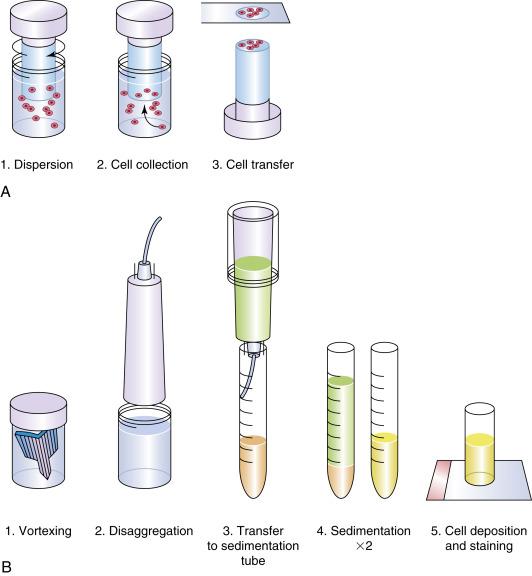
A multicenter, split-sample study found that the ThinPrep detected 18% more cytologic cases of LSIL and more serious lesions as compared with smears, with no significant difference in the detection of organisms. A number of studies have shown significant increases in the detection of cytologic HSIL after the implementation of the ThinPrep. Subsequent meta-analyses and a prospective randomized trial, however, failed to demonstrate a significant difference between smears and ThinPrep in the detection of histologic CIN2,3. Data suggest that the ThinPrep is equivalent to the smear in the detection of endocervical adenocarcinoma in situ and endometrial disease. The ThinPrep collection vial has been approved by the FDA for testing for HPV, useful for primary screening alongside the pap (“cotesting”) and for managing women whose Pap test results show atypical squamous cells (ASC).
TriPath Imaging (acquired by Becton Dickinson in 2006) developed the SurePath Pap test (formerly AutoCyte Prep) for samples collected in a mostly ethanol-based transport medium (BD SurePath Preservative Fluid). The process is shown in Fig. 1.1B . Unlike the ThinPrep method, the practitioner snips off the tip of the collection device and includes it in the sample vial. Red blood cells and some leukocytes are eliminated by density centrifugation. In addition to preparing an evenly distributed deposit of cells in a circle 13 mm in diameter, the method incorporates a final staining step that discretely stains each individual slide.
A multicenter, split-sample clinical trial showed a 7.2% increase in the detection of cytologic LSIL and more serious lesions, as well as a significant decrease in the percentage of unsatisfactory specimens. As with ThinPrep, however, subsequent meta-analyses failed to demonstrate a significant difference between smears and SurePath in the detection of histologic CIN2,3.
Automated cytology screening devices have been under development since the 1950s. The first computerized screening system was developed in the United States by Airborne Instruments Inc. and was called the Cytoanalyzer. In preclinical trials it did not perform as well as expected, and the project was discontinued. The difficulty of the task was soon appreciated, especially the inherent problems with analyzing smears prepared in the conventional manner. Despite setbacks, research into cervical cytology screening continued throughout the following decades, with the development of the TI-CAS, Quantimet, BIOPEPR, CERVIFIP, CYBEST, DIASCANNER, FAZYTAN, and LEYTAS. Some of these instruments are now in museums, but others have served as prototypes for systems that are now commercially available.
In the 1990s, researchers in the United States and Canada established private enterprises supported by venture capital to develop a commercial automated screening instrument. Foremost in the field were AutoCyte (formerly Roche Image Analysis Systems), Cytyc, Neopath, and Neuromedical Systems. A three-way merger took place in 1999, when AutoCyte, after purchasing the intellectual property of Neuromedical Systems, merged with Neopath to form a new company called TriPath Imaging, acquired in 2006 by Becton Dickinson. In 2007, Cytyc Corporation, developer of the ThinPrep Pap Test and ThinPrep Imaging System (TIS), merged with Hologic Inc. and became a wholly-owned subsidiary of Hologic.
In 1998, the FDA approved the AutoPap System (now called the FocalPoint Slide Profiler; BD TriPath Imaging, Burlington, NC) as a primary screener for cervicovaginal smears, followed by approval in 2002 for use with SurePath slides. In 2003, the FDA approved the TIS (Hologic, Marlborough, MA) as a primary screener for ThinPrep Pap slides, and in 2008 it approved the FocalPoint Guided Screening (GS) Imaging System. Neither is approved in the United States for automated screening of nongynecologic cytology specimens.
The TIS uses the principle of location-guided screening to aid the cytotechnologist in reviewing a ThinPrep Pap slide. The TIS consists of two components, the Image Processor (”imager”) and the Review Scope ( Fig. 1.2A–B ). Stained and coverslipped ThinPrep slides are placed in a cartridge (each cartridge holding 25 slides), and up to 10 cartridges are loaded onto the bench-top imager. The imager has the capacity to screen more than 300 slides per day. It scans the slides and identifies 22 fields of view (FOV) on each slide that, based on optical density measurements and other features, are the most likely to harbor abnormal cells. The x- and y-coordinates of the 22 FOVs are stored in a database and retrieved at a later time. The server is electronically linked to one or more Review Scopes in the laboratory. A Review Scope resembles a standard microscope but is augmented with an automated stage, a pod that controls the stage and objectives, and a keypad. The scope also has a camera that reads the slide identifier when the slide is loaded onto the stage. When a valid slide identifier is recognized, the server sends its coordinate information to the scope, permitting the cytotechnologist to navigate to the 22 FOVs using the pod. Navigation to each FOV is done geographically, that is, using the shortest distance from one FOV to the next. The cytotechnologist uses the pod to advance forward or return back through the FOVs, changing objectives as needed. If no abnormal cells are found in any of the FOVs, the case has been completed and can be reported as negative. If any abnormal cells are found in any of the FOVs, a review of the entire slide must be performed. This can be done using the “Autoscan” function on the Review Scope, with preset, customized user screening preferences. The Review Scope has both electronic and physical slide dotting capabilities.
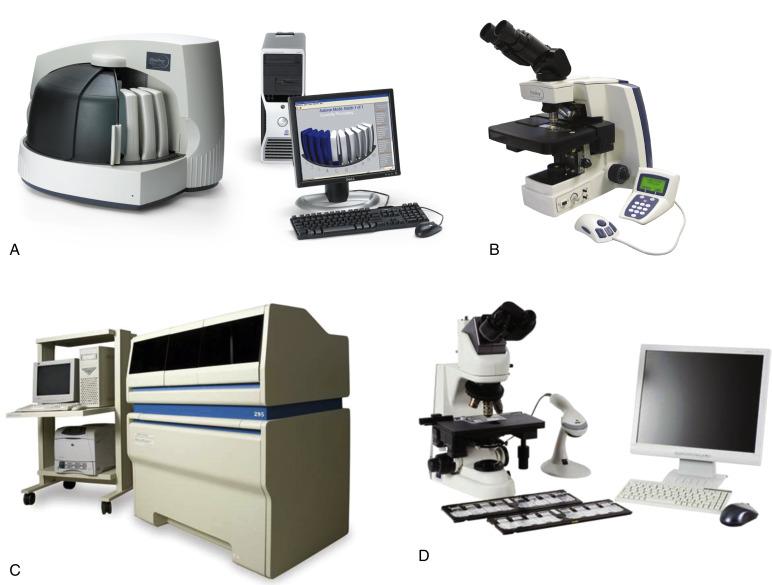
The accuracy of the TIS was evaluated in a clinical trial at four laboratories. ThinPrep slides were first screened manually and the results recorded. They were then rescreened using the TIS. Truth adjudication was performed by expert review of all abnormal cases and a proportion of negative slides. The TIS detected significantly more abnormal slides (ASC-US or greater) than manual review (82% versus 76%). A later split-sample study comparing smears versus the TIS for ThinPrep slides showed a significantly higher detection rate of histologic HSIL (CIN2,3) with the TIS. Because 22 FOVs represent approximately 25% of the ThinPrep cell spot, implementation of the TIS enhances productivity.
Implementing the TIS requires adopting the proprietary ThinPrep Pap stain, to which some adjustment is necessary because it yields darker nuclear staining of metaplastic and endocervical cell clusters than most traditional Pap stains. The TIS does not eliminate false-negative results, which are still encountered, albeit less frequently than in the absence of imaging. A number of postapproval studies have shown significant increases in the detection of cytologic LSIL and HSIL after implementation of the TIS.
The FocalPoint Slide Profiler (FPSP) uses programmed algorithms to measure cellular features such as nuclear size, integrated optical density, nuclear-to-cytoplasmic ratio, and nuclear contour—morphologic features established using planimetry and ocular micrometry for the diagnosis of squamous and glandular lesions. The device assigns a score to each slide that conveys the risk of an abnormality.
AutoPap, the predecessor of FPSP, was originally intended as a primary screening device that would eliminate the need to manually screen as many as one-half of all smears. It was temporarily redesigned as a quality control rescreening device called the AutoPap 300 QC System and obtained FDA approval for this function in 1995. The AutoPap 300 QC System did not find a wide audience, however, and became obsolete in the year 2000. A redesign resulted in a new instrument, the AutoPap System-Primary Screener, later renamed FPSP, which obtained FDA approval as a primary screening device in 1998. In this mode, the device is used in the initial screening of smears: it identifies up to 25% of slides as requiring “no further review” based on a low slide score. Of the remaining (higher scoring) slides that require manual review, it also identifies at least 15% (the highest scoring slides) for a second manual review, which may be used as a substitute for the 10% review of negative Pap test results required of all US laboratories (see Chapter 19 ). A barcode is applied to each slide and slides are loaded into slide trays. Up to 288 slides can be loaded at a time (eight slides per tray, 36 trays). Each slide is analyzed using preset algorithms at 4× magnification for a visual map of the entire slide, then 1000 fields are captured at 20× magnification. After analysis, the device assigns a score (from 0 to 1.0) to each slide according to the likelihood of an abnormality. Slides below a cutoff are considered “no further review,” and those above the cutoff are triaged for full manual review. Any slide deemed unsuitable for analysis because of preparation or coverslipping problems requires manual review.
The accuracy of the FPSP was evaluated in a clinical trial at five laboratories. Each slide was first evaluated in the conventional manner. The same slides were then processed by the AutoPap System, which detected significantly more abnormal slides—ASCs of undetermined significance (ASC-US) or greater—than conventional practice (86% versus 79%). Importantly, FPSP is not approved for women at high risk for cervical cancer. Thus a laboratory that uses FPSP for primary screening must set aside all Pap test results from high-risk women for manual screening. It is up to the laboratory to define what constitutes a Pap test result from a high-risk patient. False-negative results are occasionally encountered with the FPSP. In the clinical trial, there were 10 false-negative results (5 ASC-US, 4 LSIL, and 1 HSIL) in the 1182 cases considered “no further review” by FPSP, and another study found 9 false-negative results (5 ASC-US and 4 LSIL) in the 296 cases considered “no further review” by FPSP. False-negative cases were at least equally identified in the manual screening arm of each study, and overall results between the manual and automated screening methods were at least equivalent. The productivity gain with FPSP is modest because in practice the FPSP archives only about 16% to 17% of Pap test results without full manual review.
At this moment, the FPSP in “no further review” mode is used by very few laboratories in the United States. The most recent phase in FocalPoint development occurred in 2008 with FDA approval of the BD FocalPoint GS Imaging System (FIS) ( Fig. 1.2C–D ). The FIS consists of the FPSP plus a BD FocalPoint GS Review Station and, like the TIS, uses the principle of location-guided screening to aid the cytotechnologist in reviewing a slide. A SurePath slide is first examined by the FPSP, which uses its algorithms to identify the 10 FOVs most likely to harbor abnormal cells. These FOVs are presented hierarchically based on slide score to a cytotechnologist for review at the microscopic Review Station; if no abnormality is detected in the FOVs, the slide is reported as negative without any further review. But if any abnormality is seen in any of the FOVs, or if specimen adequacy cannot be confirmed, the slide is triaged for full manual review.
The accuracy of the FIS was evaluated in a clinical trial at four laboratories. The detection of cytologic HSIL+ increased by 20% and for cytologic LSIL+ by 10% in the computer-assisted arm, with small but statistically significant decreases in specificity. For cytologic ASC-US+ sensitivity and specificity, the study arms were not statistically different. As with the TIS, implementation of the FIS enhances productivity.
FocalPoint instrumentation is in use outside the United States, predominantly in Europe, Asia, and Canada, but with slightly different methods. Cervical smears or LBC are scanned, and combinations of guided screening with “slide profiling” are in use. In this method, a low-scoring “no further review” population of slides is archived without further manual screening, whereas the higher scoring “review” population of slides undergoes guided screening as described above.
The sensitivity of cytology for detecting preinvasive squamous and glandular lesions is difficult to establish, but it is clearly far from perfect. Most studies of preinvasive lesions suffer from verification bias (i.e., cases are referred for biopsy on the basis of an abnormal smear, and women with negative Pap test results are not biopsied). The few relatively unbiased studies show that the mean sensitivity of the Pap test is 47% (range 30% to 80%), and the mean specificity is 95% (range 86% to 100%).
The sensitivity of cytologic study is less than ideal for invasive cancers as well, and estimates range widely (16% to 82%). Many women with cervical cancer have a history of one or more negative smears. The majority (56%) of women who develop invasive cervical cancer in the United States have not had a Pap test in the preceding 3 years. The relative contributions of sampling and laboratory error vary from one study to another and likely depend on how carefully retrospective rescreening is performed.
False-positive diagnoses of cervical cancer occur in 10% to 15% of cases. The chief culprits are the atrophic smear with benign squamous atypia in a granular, pseudonecrotic background; reparative changes; and keratinizing HSILs.
The interobserver reproducibility of cytologic interpretations is also less than perfect. In a large study of women, most of whom had mild cytologic abnormalities, the unweighted kappa statistic for four categories of diagnosis—negative, atypical, LSIL, and HSIL—was 0.46, indicating moderate reproducibility. (Roughly, a κ of 0 or less represents poor agreement, 0–0.2 slight agreement, 0.2–0.4 fair agreement, 0.4–0.6 moderate agreement, 0.6–0.8 very good agreement, and 0.8–1.0 almost perfect agreement.) In the same study, the reproducibility of histologic interpretations of cervical biopsies, also for four categories of diagnosis, was identical (0.46). The greatest disagreement with Pap test results involved those originally interpreted as showing ASC-US; the second reviewer agreed with only 43% of cases. The greatest disagreement with biopsy specimens involved those originally interpreted as CIN1; the second reviewer concurred in only 43% of cases.
Papanicolaou devised a numerical system for reporting cervical smears, which was originally intended to convey his degree of suspicion that the patient had cancer:
Class I, absence of atypical or abnormal cells
Class II, atypical but no evidence of malignancy
Class III, suggestive of but not conclusive for malignancy
Class IV, strongly suggestive of malignancy
Class V, conclusive for malignancy
Over time the Papanicolaou class system underwent many modifications and was not used in a uniform fashion, but it persisted in many laboratories well into the 1980s. In other laboratories it was replaced (or supplemented) by descriptive terms borrowed from histologic classifications of squamous lesions. Squamous cancer precursors were originally divided into carcinoma in situ, a high-risk lesion of immature, undifferentiated atypical cells, and dysplasia (subdivided into mild, moderate, and severe), the latter a lower-risk lesion of more mature squamous cells. In the 1960s, Richart challenged the duality of dysplasia/carcinoma in situ and proposed a new term, cervical intraepithelial neoplasia (CIN). CIN was graded from 1 to 3, but Richart and Barron believed that CIN 1 (mild dysplasia) had a strong propensity to progress to CIN 3 and cancer. The high rate of progression found in their study most likely related to stringent entry criteria: for inclusion, CIN 1 had to be confirmed on three consecutive Pap tests. Richart’s data showed a higher progression rate for mild dysplasia than most other natural history studies. The CIN concept was highly influential, however, and for many years squamous precursors were treated as much on the basis of their size and location as on their grade.
In 1989 the Bethesda System was introduced to standardize the reporting of cervical cytology results and incorporate new insights gained from the discovery of HPV. The name for a squamous cancer precursor was changed to squamous intraepithelial lesion (SIL), subdivided into only two grades (low and high) based on the evolving understanding of the biology of HPV. In this system, LSIL encompasses CIN 1, and HSIL encompasses CIN 2 and 3. This was a shift away from the CIN concept, one based on a reevaluation of the existing evidence, which demonstrated that most LSILs are, in fact, transient HPV infections that carry little risk for oncogenesis, whereas most HSILs are associated with viral persistence and a significant potential for progression to invasive cancer. Since 2013, a two-grade reporting terminology has been recommended for the histopathologic reporting of genital and anal HPV-related lesions.
The first Bethesda System workshop, in 1988, was followed by three others, in 1991, 2001, and 2014, which made modifications to the original framework, terminology, or both. The 2014 Bethesda System, like its predecessors, recommends a specific format for the cytology report, including an explicit statement on the adequacy of the specimen, a general categorization, and an interpretation/result.
One of the most important advances of the Bethesda System is its recommendation that each Pap report include an explicit statement of adequacy. In 1988, the Bethesda System proposed three categories for specimen adequacy: “satisfactory,” “less than optimal” (renamed “satisfactory but limited by ….” in 1991), and “unsatisfactory.” The 2001 Bethesda System eliminated the middle category because it was confusing to clinicians and prompted unnecessary repeat Pap tests. Nevertheless, the 2014 Bethesda System advocates mentioning the presence or absence of a transformation zone component and permits comments on obscuring elements.
It is easy to determine whether a specimen is adequate or unsatisfactory in most cases. Slides received without patient identification or broken beyond repair should be rejected as unsatisfactory. An appropriately labeled smear with an adequate complement of well-preserved squamous and endocervical cells is clearly satisfactory. About 1% or less of Pap test results are interpreted as unsatisfactory. Unsatisfactory Pap test results can be finalized by a cytotechnologist and need not be reviewed by a cytopathologist (see Chapter 19 ). One of the components of an adequate Pap test result is an adequate squamous component , defined as a minimum estimated number of well-preserved, well-visualized squamous cells, the minimum being different for smears versus liquid-based preparations:
The minimum number of squamous cells for adequacy depends on the preparation method:
Liquid-based: 5000
Smear: 8000–12,000
The minimum number of 5000 squamous cells for an adequate LBC Pap test result was based on correlations made between the false-negative rate and squamous cell cellularity. Because LBCs likely represent a more homogeneous representation of the material obtained by the collection device, a more stringent squamous cellularity requirement was imposed on smears.
The cellularity of the squamous cell component is estimated; laboratories are not expected to count individual cells. With experience, an adequate squamous cell component is apparent in most cases. In borderline cases, techniques are available for estimating adequacy: reference images for smears and a spot-counting procedure for liquid-based preparations.
A spot-counting method is used to evaluate LBCs with borderline squamous cellularity. A minimum of ten fields are counted along a diameter that includes the center of the slide ( Fig. 1.3A ). If the cell circle has blank spots, these should be represented in the fields counted ( Fig. 1.3B ). The average number of squamous cells is then compared against tables that take into account the objective, the eyepiece field number, and the diameter of the circle that contains cellular material. For example, with an Field Number 20 (FN 20)) eyepiece and a ×40 objective, the sample is adequate if the average number of squamous cells counted is greater than 3.1 for a ThinPrep slide.
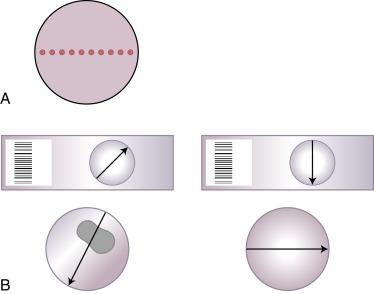
An additional slide can be prepared when the initial slide has insufficient cellularity, in the hopes that the new slide will be more cellular. The addition of a washing step with 10% glacial acetic acid increases the percentage of satisfactory ThinPrep Pap test results, uncovering occasional cases of SIL and invasive cancer. Adequacy should be assessed individually, however, not cumulatively; two unsatisfactory slides do not add up to a satisfactory slide.
Squamous cellularity is sometimes difficult to estimate, for example, when there is marked cell clustering or cytolysis. In certain clinical settings, particularly in women with atrophy and after radiation therapy to the pelvis, a lower number may be adequate. In these situations, cytologists are expected to use their judgment when evaluating adequacy rather than rigidly applying the numerical criteria.
For women with an unsatisfactory Pap test result, repeat cytologic study in 2 to 4 months is recommended. In women with an unsatisfactory Pap test result and a positive HPV test result, either a repeat Pap test in 2 to 4 months or colposcopy is acceptable.
In the 2014 Bethesda System, the presence or absence of an endocervical/transformation zone component is noted on the report. An endocervical component is considered present if 10 or more endocervical or squamous metaplastic cells, either isolated or in groups, are present. The data on the endocervical component as a measure of sample adequacy are contradictory. The importance of endocervical cells was first suggested by cross-sectional studies, which showed that smears are more likely to contain SIL when endocervical cells are present. Data from retrospective case–control studies, however, do not support this: investigators have found no association between false-negative Pap test results and the absence of endocervical cells. Retrospective cohort studies have shown that women whose initial smears lack endocervical cells do not develop more lesions on follow-up than women whose smears do have an endocervical component, implying that an endocervical component is not essential. Currently, a smear without endocervical cells is not considered unsatisfactory, although the absence of an endocervical/transformation zone component is mentioned as a “quality indicator.” A repeat Pap test is not necessary.
The general categorization is an optional component of the Bethesda System.
Negative for intraepithelial lesion or malignancy
Other: See Interpretation/Result
Epithelial cell abnormality: See Interpretation/Result
“Other” includes benign-appearing endometrial cells in women over 45 years of age. Specimens are categorized according to the most significant abnormality identified.
Recommended terminology for reporting findings is listed in Table 1.2 . Mentioning nonneoplastic findings, other than organisms, is optional, given that many clinicians desire the Pap test report to be as concise as possible. Findings of no clinical consequence, if mentioned, may result in confusion and even unnecessary repeat testing. Nevertheless, many cytologists believe it is important to document that certain findings were interpreted as benign, particularly those that can mimic a neoplasm.
| SPECIMEN ADEQUACY |
| Satisfactory for evaluation |
| Unsatisfactory for evaluation |
| GENERAL CATEGORIZATION (Optional) |
| Negative for Intraepithelial Lesion or Malignancy (NILM) |
| Other |
| Epithelial Cell Abnormality |
| INTERPRETATION/RESULT |
| NEGATIVE FOR INTRAEPITHELIAL LESION OR MALIGNANCY |
| NONNEOPLASTIC FINDINGS (optional to report) |
| Squamous metaplasia |
| Keratotic changes |
| Tubal metaplasia |
| Atrophy |
| Pregnancy-associated changes |
| Reactive cellular changes associated with: |
| • Inflammation (includes typical repair) |
| • Radiation |
| • Intrauterine contraceptive device (IUD) |
| Glandular cells status post hysterectomy |
| ORGANISMS |
| Trichomonas vaginalis |
| Fungal organisms morphologically consistent with Candida species |
| Shift in flora suggestive of bacterial vaginosis |
| Bacteria morphologically consistent with Actinomyces species |
| Cellular changes consistent with herpes simplex virus |
| Cellular changes consistent with cytomegalovirus |
| OTHER |
| Endometrial cells in a woman ≥45 years of age |
| EPITHELIAL CELL ABNORMALITIES |
| SQUAMOUS CELL |
| Atypical squamous cells (ASC) |
|
|
| Low-grade squamous intraepithelial lesion (LSIL) |
| High-grade squamous intraepithelial lesion (HSIL) |
| Squamous cell carcinoma |
| GLANDULAR CELL |
| Atypical endocervical cells, NOS |
| Atypical endometrial cells, NOS |
| Atypical glandular cells, NOS |
| Atypical endocervical cells, favor neoplastic |
| Atypical glandular cells, favor neoplastic |
| Endocervical adenocarcinoma in situ (AIS) |
| Adenocarcinoma |
|
|
|
|
| OTHER MALIGNANT NEOPLASMS ( specify ) |
| ADJUNCTIVE TESTING |
| COMPUTER-ASSISTED INTERPRETATION |
| EDUCATIONAL NOTES AND COMMENTS ( optional ) |
A normal Pap test result is reported as “Negative for Intraepithelial Lesion or Malignancy” (NILM). Additional findings (e.g., reactive changes, infectious organisms) are listed subsequently. Approximately 90% of Pap test results are interpreted as NILM. Pap test results, with the exception of those cases that show reactive/reparative changes, can be finalized by a cytotechnologist in the United States and need not be reviewed by a pathologist (see Chapter 19 ). In the United States, a pathologist is required to review cases that show reactive/reparative changes and any abnormality at the level of ASC-US or higher. This represents about 10% to 20% of the total Pap volume in most laboratories.
The ectocervix is lined by a stratified squamous epithelium that matures under the influence of estrogen. The most mature squamous cells are called superficial cells . They have a small, pyknotic nucleus that is 5 to 6 μm in diameter. Intermediate cells have a larger nucleus measuring 8 μm in diameter, which is not pyknotic but instead has a finely granular texture. Intermediate cells are occasionally binucleated and even multinucleated. Both superficial and intermediate cells are large polygonal cells with transparent pink or green cytoplasm ( Fig. 1.4 ). Superficial and intermediate cells are the predominant cells in cytologic samples from women of reproductive age.
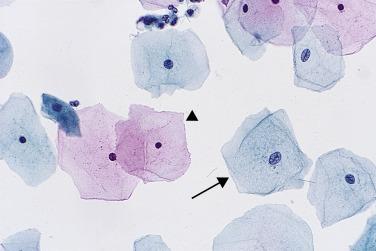
Immature squamous cells are called parabasal cells and basal cells . Because a Pap test does not usually scrape off the entire thickness of the epithelium but only the upper few layers, immature cells near the base of a mature epithelium are not usually sampled. An immature epithelium, however, is composed throughout its thickness by parabasal-type or basal-type cells. Immature epithelium is common at the transformation zone, where it is called squamous metaplasia, and whenever there is squamous epithelial atrophy due to a low estrogen state. Thus so-called “parabasal” and “basal” cells are typically obtained from squamous metaplasia or atrophic epithelium. Squamous atrophy is encountered in a variety of clinical settings associated with a low estrogen state.
Premenarche
Postpartum
Postmenopause
Turner syndrome
Status post bilateral oophorectomy
Parabasal cells are round or oval rather than polygonal and have a variably sized nucleus that is usually larger than that of an intermediate cell. Basal cells are even smaller and have very scant cytoplasm ( Fig. 1.5 ).
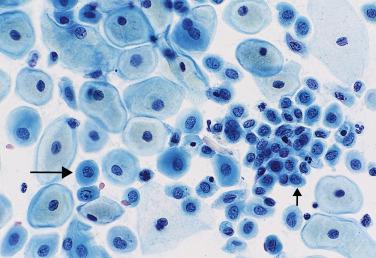
Basal and parabasal cells are the hallmark of atrophy. With a deeply atrophic cervical epithelium, no superficial or intermediate cells are seen, only parabasal and basal cells. In addition, atrophic epithelium, particularly in postmenopausal women, is prone to injury and inflammation and often shows a spectrum of changes that should be recognized as normal and not confused with a significant lesion. Sheets of immature squamous cells are crowded and syncytium-like, mimicking the crowded cells of an HSIL ( Fig. 1.6A ). Nevertheless, the chromatin texture in atrophy is finely granular and evenly distributed, nuclear contours remain mostly smooth and thin, and mitoses are generally absent. A curious variant, transitional cell metaplasia , is notable for prominent longitudinal nuclear grooves (“coffee-bean nuclei”), wrinkled nuclei, and small perinuclear halos ( Fig. 1.6B ). Cellular degeneration is seen in some cases of atrophy ( Fig. 1.7A ). Dark blue, rounded, amorphous masses known as “blue blobs,” thought to represent either condensed mucus or degenerated bare nuclei, are sometimes seen ( Fig. 1.7B ), as is a granular background (see Fig. 1.7A ) that resembles the necrosis associated with invasive cancers.
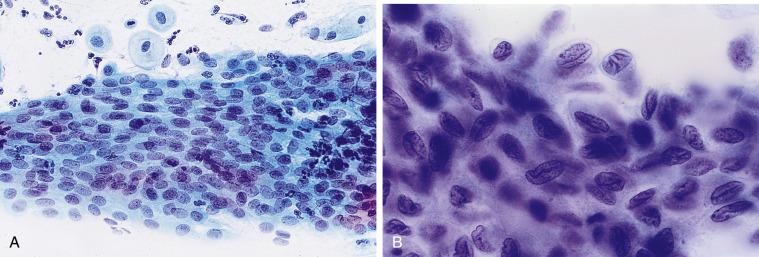
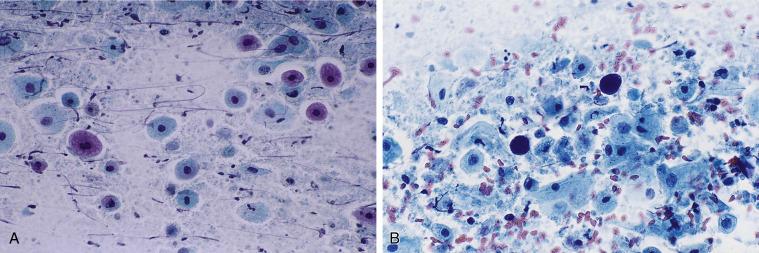
Parabasal-type cells are also the constituents of squamous metaplasia of the endocervix. Squamous metaplasia is a common morphologic alteration of the endocervical epithelium usually limited to the transformation zone in women who otherwise have good squamous maturation. It is identified cytologically as flat sheets of immature squamous cells, often arranged in an interlocking fashion like paving stones ( Fig. 1.8 ). They may show mild variation in nuclear size, with slightly irregular contours and slight hyperchromasia.
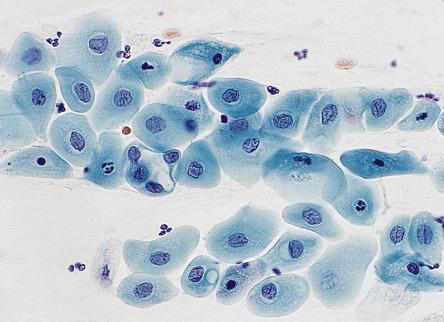
Squamous metaplasia, as defined cytologically, is always composed of immature squamous cells. So-called mature squamous metaplasia , a histologic term describing mature squamous epithelium overlying endocervical glands, is not recognized as such on cytologic preparations.
Other normal changes of squamous cells are hyperkeratosis and parakeratosis. Hyperkeratosis is a benign response of stratified squamous epithelium due to chronic mucosal irritation, as in uterine prolapse. Anucleate, mature, polygonal squamous cells appear as isolated cells or plaques of tightly adherent cells ( Fig. 1.9A ). Such cells are benign and should not be considered abnormal. This cytologic picture is mimicked by contamination of the slide by squamous cells of the vulva or skin from the fingers of the persons handling the slide.

Parakeratosis , a benign reactive change also caused by chronic irritation, is characterized by small, heavily keratinized squamous cells with dense orangeophilic cytoplasm and small, pyknotic nuclei ( Fig. 1.9B ). When such densely keratinized cells show nuclear atypia in the form of enlargement and membrane irregularity, they are called “atypical parakeratosis” and should be categorized as an epithelial cell abnormality (see further on).
The endocervix is lined by mucin-producing columnar cells that have abundant vacuolated cytoplasm and a basally placed nucleus with finely granular chromatin. Nucleoli are inconspicuous but become prominent in reactive conditions such as cervicitis. Endocervical cells are often identified in strips or sheets rather than as isolated cells ( Fig. 1.10 ). When arranged as strips, the cells have the appearance of a picket fence. When in sheets, they resemble a honeycomb because of the well-defined cell borders and uniform cell arrangement. Rarely, mitoses are identified. They should not raise suspicion of a neoplasm if the cells are otherwise normal in appearance. Tubal metaplasia is a benign alteration of the endocervical epithelium found in about 30% of cone biopsy and hysterectomy specimens ( Fig. 1.11 ).
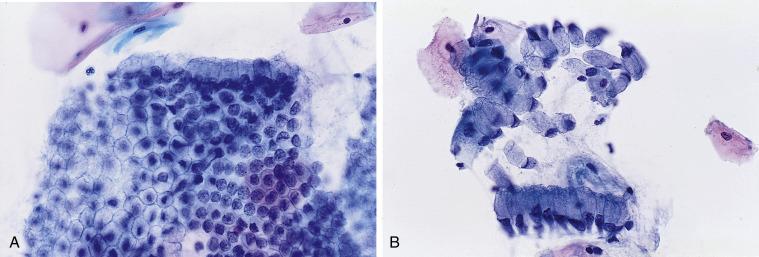
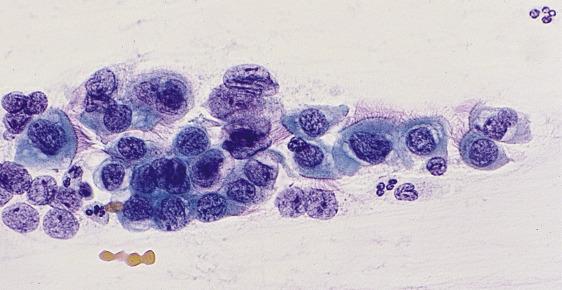
Spontaneously exfoliated, menstrual endometrial cells are seen if the Pap test specimen is taken during the first 12 days of the menstrual cycle.
Balls of small cells
Isolated small cells
Scant cytoplasm
Dark nucleus
Nuclear molding
Nuclear fragmentation
Exfoliated endometrial cells are most easily recognized when they are arranged in spherical clusters ( Fig. 1.12A ). They are small, with a dark nucleus and (usually) scant cytoplasm; occasional cells may have more abundant, clear cytoplasm. Clusters have a scalloped contour due to the slight protrusion of individual cells. Apoptosis is common. Isolated endometrial cells are also seen, but they are less conspicuous because of their small size.

Occasionally, endometrial cell clusters consist of an obvious dual cell population, with small, dark stromal cells (in the center) and larger glandular cells (around the edges) ( Fig. 1.12B ). Most endometrial cell clusters, however, do not have this dual population; clusters like that in Fig. 1.12A might be of endometrial glandular or stromal origin or a mix of both and are best referred to simply as “exfoliated endometrial cells.”
Shedding endometrial cells after day 12 (“out of phase”) is associated with endometritis, endometrial polyps, and intrauterine devices (IUDs). In a young woman, abnormal shedding is almost never due to endometrial adenocarcinoma. For this reason, endometrial cells need not be mentioned in the report for women under 45 years of age. Sometimes a pathologist might do so anyway, to document that the cells were identified and interpreted as benign endometrial cells. Endometrial cells are notorious for their ability to cause diagnostic difficulty because a variety of neoplastic cells resemble endometrial cells. In a woman 45 years of age or older, benign-appearing endometrial cells are reported because of the small risk of endometrial neoplasia.
HSIL
Squamous cell carcinoma
Adenocarcinoma in situ
Small cell carcinoma
The differential diagnosis includes a number of very significant lesions that mimic endometrial cells and thus are sometimes mistakenly interpreted as normal, particularly if the woman is in the first 12 days of her menstrual cycle. Attention to certain cytologic details can help avoid some if not all of these misattributions. A minority of HSILs are comprised of relatively small cells. Like endometrial cells, their nuclei are dark, and they have scant cytoplasm ( Fig. 1.13A ). HSIL cells, even when small, are usually bigger than endometrial cells, vary more in size, and have denser cytoplasm. HSIL clusters are usually less well circumscribed and not as spherical as endometrial cell balls. Some poorly differentiated squamous cell carcinomas are comprised of small dark cells that mimic endometrial cells to perfection ( Fig. 1.13B ). In such cases, suspicious clinical findings (e.g., postcoital bleeding) might be the only clue to the correct interpretation. Most AIS have a columnar cell structure, but a minority are made up of smaller and rounder cells ( Fig. 1.13C ), particularly with liquid-based preparations. Careful examination for focal columnar differentiation and mitoses can be very helpful. The rare small cell carcinoma of the cervix may display crush artifact ( Fig. 1.13D ), which is rarely seen with endometrial cells.
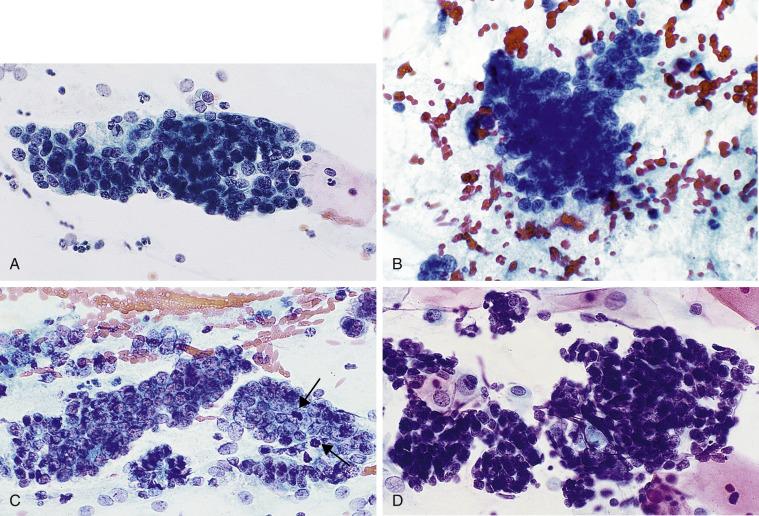
The endocervical sampling device occasionally inadvertently samples the LUS or endometrium. This is especially likely when the endocervical canal is abnormally shortened, such as after a cone biopsy or trachelectomy.
Large and small tissue fragments
Glands and stroma
Stromal cells
Uniform
Oval or spindle-shaped
Finely granular chromatin
Occasional mitoses
Capillaries traverse larger fragments
Glands
Tubular
Straight or branching
Mitoses (some cases)
Extreme nuclear crowding
Scant cytoplasm
The characteristic feature is the combination of glands and stroma, often in large fragments ( Fig. 1.14A–C ), either together or separated. Glandular cells of the LUS resemble endocervical cells, but have a higher nuclear-to-cytoplasmic ratio, are more hyperchromatic, and can be mitotically active. Because of their very high nuclear-to-cytoplasmic ratio, there’s a risk of confusion with a significant squamous or glandular lesion.
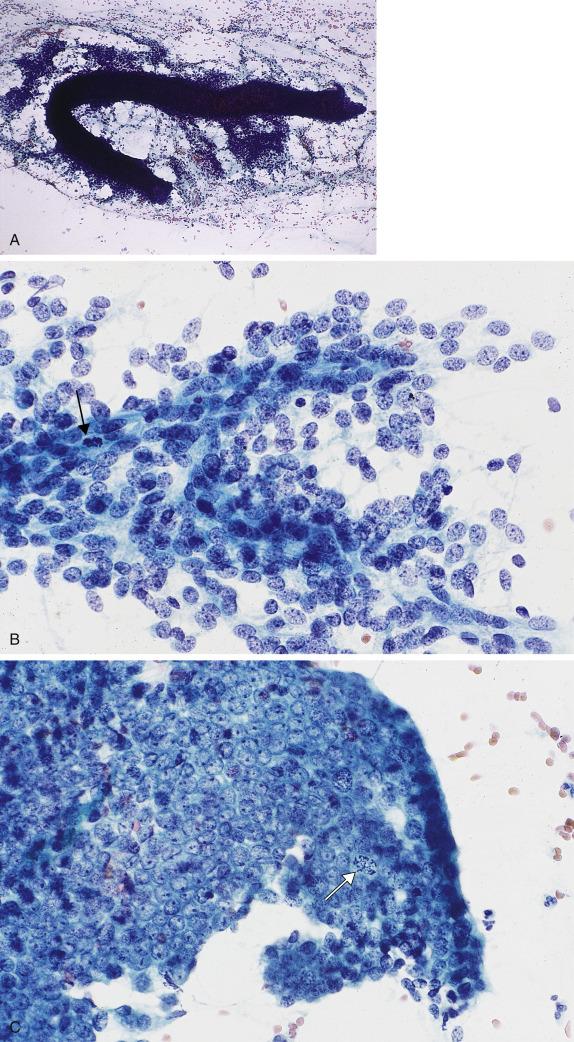
Syncytiotrophoblastic cells from placental tissue are seen very rarely, perhaps in about 0.1% of Pap test results from pregnant women. The cells are large, with abundant blue or pink cytoplasm. They have multiple nuclei that have a granular chromatin texture and slightly irregular contours. Trophoblastic cells can be distinguished from multinucleated histiocytes because their nuclei are darker and more irregular in contour ( Fig. 1.15 ). They do not show the prominent molding and ground-glass appearance of nuclei of herpes simplex infection. Immunostains for human chorionic gonadotropin and human placental lactogen can be used to confirm their identity as trophoblastic cells. The presence of syncytiotrophoblastic cells is not a reliable predictor of an impending abortion.
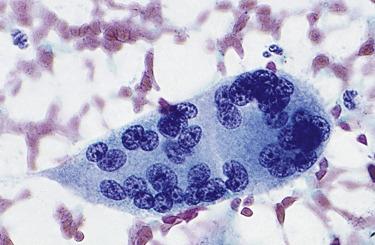
Decidual cells may be seen during pregnancy and the postpartum period, but they are often difficult to recognize and identify as such. They are usually isolated cells with abundant granular cytoplasm, a large vesicular nucleus, and a prominent nucleolus. They often show degenerative changes.
Neutrophils are seen in all Pap samples and do not necessarily indicate infection, but they are present in increased numbers after injury or infection. Lymphocytes and plasma cells are rare, but occasionally—most often in older women—they are numerous ( Fig. 1.16A–B ). This pattern is called follicular cervicitis because biopsy specimens show lymphoid follicle formation. The lymphocytes of follicular cervicitis can be confused with HSIL cells, endometrial cells, and lymphoma. Histiocytes are associated with a myriad of conditions (e.g., menses, pregnancy, foreign bodies, radiotherapy, and endometrial hyperplasia and carcinoma) ( Fig. 1.17 ), but by themselves are a nonspecific finding of no clinical significance.

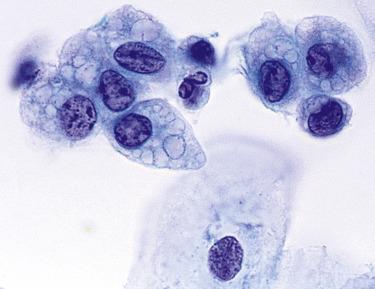
The vagina is colonized by Gram-positive rod-shaped bacteria of the genus Lactobacillus . They are beneficial because they produce lactic acid, which reduces the ambient pH and possibly protects from infection by Candida and other pathogens. Lactobacilli metabolize the glycogen contained within exfoliated squamous cells. The resulting cellular pattern, commonly seen during the second (luteal) phase of the menstrual cycle, is known as cytolysis —bare intermediate cell nuclei, fragments of squamous cytoplasm, and abundant bacterial rods ( Fig. 1.18 ). Cytolysis can interfere with one’s ability to evaluate the nuclear-to-cytoplasmic ratio, an important criterion in grading SILs.
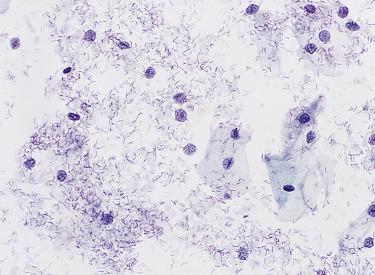
Artifacts and specimen contaminants such as trichomes are illustrated in Fig. 1.19 . For laboratories that use the ThinPrep method, one of the most commonly encountered artifacts happens when the sample is contaminated by a lubricant, gel, or vaginal medication containing carbomers or Carbopol polymers ( Fig. 1.19B ). These interfere with cellular deposition during slide preparation, resulting in an unsatisfactory slide. A note in the report can be helpful, for example:
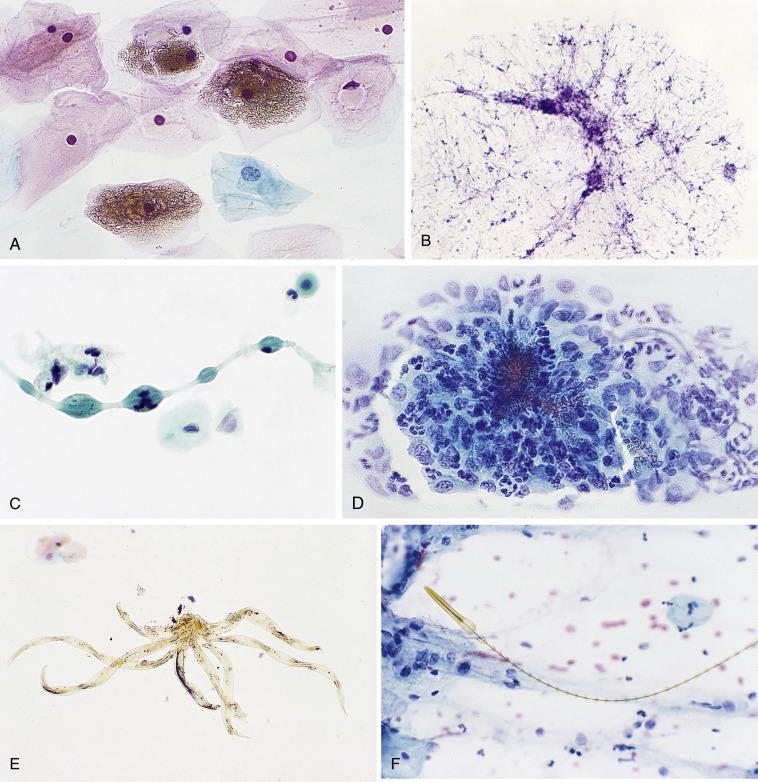
NOTE: This sample appears to be unsatisfactory due to the presence of an obscuring material, possibly lubricant. Nonapproved lubricants, and some gels or medications, may contain ingredients that interfere with Pap slide preparation (notably carbomers and Carbopol polymers). Of note, disposable specula may be precoated with interfering lubricants. In all cases, lubricant should be used sparingly when obtaining a Pap. For more information, please contact the Cytology Laboratory.
“String of pearls” is the descriptive name given to an uncommon but striking artifact seen with ThinPrep Pap tests: a long string with bulbous excrescences ( Fig. 1.19C ). The cause is unclear, but it might represent a tight coil of mucus. Although originally described in a case report from a postmenopausal woman, they can be seen at any age.
Become a Clinical Tree membership for Full access and enjoy Unlimited articles
If you are a member. Log in here